人教版初一英语上册总复习资料
新人教版七年级英语上册重点知识复习资料(全册)

新人教版七年级英语上册重点知识复习资料(全册)Starter Unit s 1-31.Good morning/afternoon/evening. 早上(上午)/下午/晚上好。
答语相同。
在熟人或家人之间可省略good。
熟人之间的问候可加上称呼语,称呼语放在问候语之后且用逗号隔开。
如:Good morning , class!同学们,早上好!△Good night!晚安(晚间告别用语)2. A: How are you? 你(身体)好吗?B: (I’m) fine/Very well/I’m OK, Thank you./thanks.How are you? / And you?我很好,谢谢。
你呢?A: (I’m)fine/OK, too.我也很好。
4. thanks = thank you 谢谢1.What’s this/that in English? 这/那用英语怎么说?It’s a/an + 单数物品(△不说This/That is...)What’s this in English? 这用英语怎么说?It’s a jacket. 夹克衫What’s that in English?那用英语怎么说?It’s an orange. 橘子。
in + 语言:用某种语言in Chinese/English/Japanese用汉/英/日语5. a 和an是不定冠词,只用在可数名词单数前面,表示“一”。
a用在以辅音音素开头的单词前;an用在以元音音素开头的单词前。
这里的元音音素和辅音音素是指读音,而不是指字母。
如:a pen /pen/ 一支钢笔(/p/为辅音音素)an orange /’ ɒrindʒ / 一个桔子(/ɒ /为元音音素)an egg / an apple / an orange / an eraser / an answer / an ID card /an e-mail / an hour/an old man / an interesting book / an exciting sport an art lesson6. Spell it, please. = Please spell it. 请拼读它。
最全面人教版七年级上册英语期末总复习归纳整理
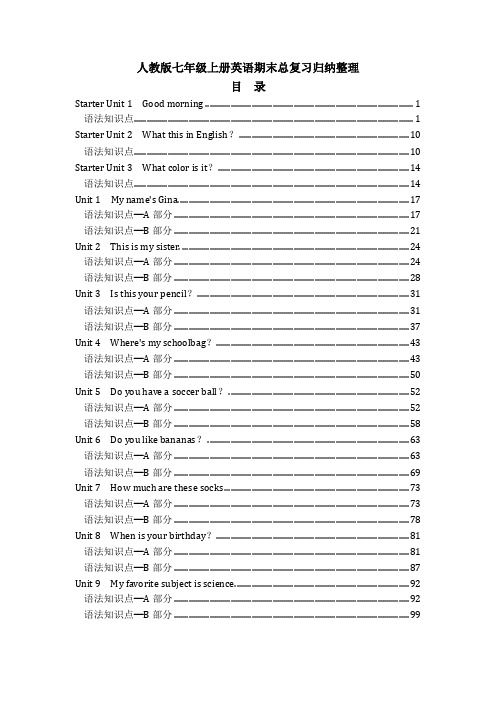
人教版七年级上册英语期末总复习归纳整理目录Starter Unit 1 Good morning (1)语法知识点 (1)Starter Unit 2 What this in English? (10)语法知识点 (10)Starter Unit 3 What color is it? (14)语法知识点 (14)Unit 1 My name's Gina (17)语法知识点━A部分 (17)语法知识点━B部分 (21)Unit 2 This is my sister. (24)语法知识点━A部分 (24)语法知识点━B部分 (28)Unit 3 Is this your pencil? (31)语法知识点━A部分 (31)语法知识点━B部分 (37)Unit 4 Where's my schoolbag? (43)语法知识点━A部分 (43)语法知识点━B部分 (50)Unit 5 Do you have a soccer ball? (52)语法知识点━A部分 (52)语法知识点━B部分 (58)Unit 6 Do you like bananas? (63)语法知识点━A部分 (63)语法知识点━B部分 (69)Unit 7 How much are these socks (73)语法知识点━A部分 (73)语法知识点━B部分 (78)Unit 8 When is your birthday? (81)语法知识点━A部分 (81)语法知识点━B部分 (87)Unit 9 My favorite subject is science (92)语法知识点━A部分 (92)语法知识点━B部分 (99)Starter Unit 1 Good morning语法知识点1、26个字母的发音、书写顺序及书写规范❶26个字母的书写规范⑴按照字母的笔顺和字母在三格中应占的位置书写。
⑵每个字母都稍向右倾斜,斜度要一致。
人教版丨七年级上册英语语法专题复习(附练习题及答案)
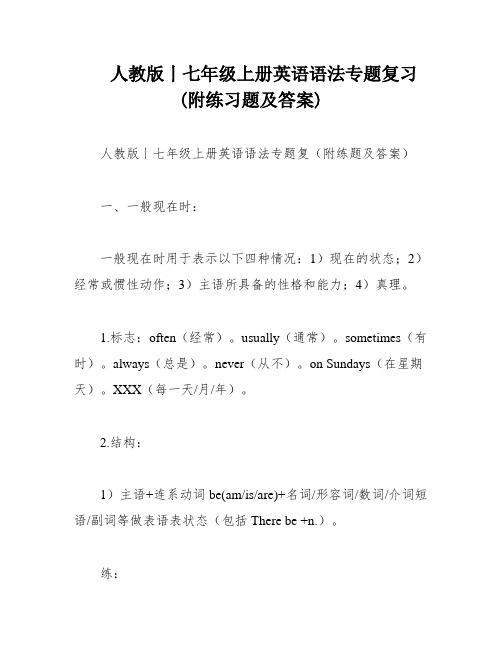
人教版丨七年级上册英语语法专题复习(附练习题及答案)人教版丨七年级上册英语语法专题复(附练题及答案)一、一般现在时:一般现在时用于表示以下四种情况:1)现在的状态;2)经常或惯性动作;3)主语所具备的性格和能力;4)真理。
1.标志:often(经常)。
usually(通常)。
sometimes(有时)。
always(总是)。
never(从不)。
on Sundays(在星期天)。
XXX(每一天/月/年)。
2.结构:1)主语+连系动词be(am/is/are)+名词/形容词/数词/介词短语/副词等做表语表状态(包括There be +n.)。
练:1.I am a student。
My name is Tom.2.Where are my shoes。
They are here.3.Who is the girl with long straight hair。
I think she is Kate.4.You and I are not in Class Six.5.XXX。
Yes。
there is.6.XXX。
No。
they aren't.2)主语(非第三人称单数)+行为动词原形+其他(用助动词do帮助构成否定句、一般疑问句和特殊疑问)。
3)主语(第三人称单数)+行为动词的第三人称单数+其他(用助动词does帮助构成否定句、一般疑问句和特殊疑问句)。
行为动词第三人称单数加-s的形式:1.-s2.辅音+y: study-studies3.以s,x,ch,sh结尾: watch-watches。
XXX4.特殊: have-has。
do-does。
go-goes。
练:1.His parents watch TV every night.肯定句:1.XXX.否定句:2.His parents do not watch TV every night.n: My brother does not do homework every day。
人教版七年级初一英语上册复习各单元知识点归纳总结
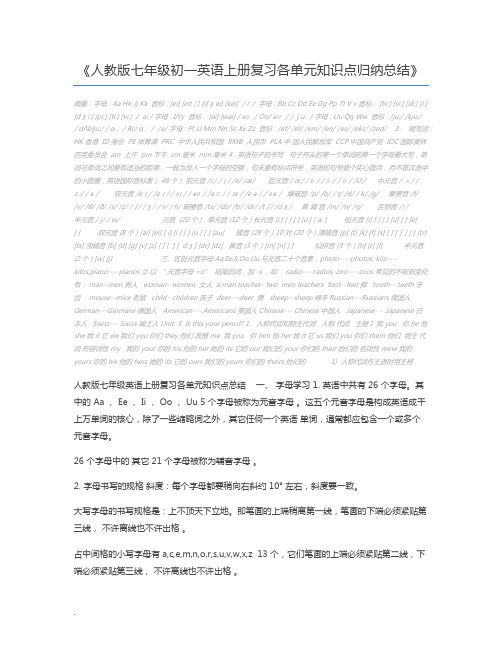
《人教版七年级初一英语上册复习各单元知识点归纳总结》摘要:字母 : Aa Hh Jj Kk 音标 : [ei] [eit ʃ ] [d ʒ ei] [kei] / i: / 字母 : Bb Cc Dd Ee Gg Pp Tt V v 音标 : [bi:] [si:] [di:] [i:] [d ʒ i:] [pi:] [ti:] [vi:] / ai / 字母 : IiYy 音标 : [ai] [wai] / əʊ / Oo/ əʊ / / j u: / 字母 : Uu Qq Ww 音标 : /ju:/ /kju://`dΛblju:/ / ɑ : / Rr/ ɑ : / /e/ 字母 : Ff Ll Mm Nn Ss Xx Zz 音标 : /ef/ /el/ /em/ /en/ /es/ /eks/ /zed/ 3 . 缩写词:HK 香港 ID 身份 PE 体育课 PRC 中华人民共和国 RMB 人民币 PLA 中国人民解放军 CCP 中国共产党 IOC 国际奥林匹克委员会 am 上午 pm 下午 cm 厘米 mm 毫米 4 . 英语句子的书写句子开头的第一个单词的第一个字母要大写,单词与单词之间要有适当的距离,一般为放入一个字母的空隙,句末要有标点符号,英语的句号是个实心圆点,而不是汉语中的小圆圈,英语国际音标表( 48 个)前元音 /i:/ / ɪ/ /e/ /æ/ 后元音 / ɑ:/ / ɒ / / ɔ :/ / ʊ / /U:/ 中元音 / ʌ / /ɜ :/ / ə / 双元音 /e ɪ / /a ɪ / / ɔɪ / / əʊ / /a ʊ / / ɪə / /e ə / / ʊə / 爆破音 /p/ /b/ / t/ /d/ / k/ /g/ 摩擦音 /f//v/ /θ/ /ð/ /s/ /z/ / ʃ / / ʒ / / r/ / h/ 破擦音 /ts/ /dz/ /tr/ /dr/ /t ʃ / /d ʒ / 鼻辅音/m/ /n/ /ŋ/ 舌侧音 / ǀ/ 半元音 / j/ / w/ 元音 (20 个 ) 单元音 (12 个 ) 长元音 [i:] [ ] [ ] [u:] [ a: ] 短元音 [i] [ ] [ ] [u] [ ] [e] [ ] 双元音 (8 个 ) [ai] [ei] [ i] [i ] [ ] [u ] [ ] [au] 辅音 (28 个 ) 10 对 (20 个 ) 清辅音[p] [t] [k] [f] [s] [ ] [ ∫ ] [ ] [tr] [ts] 浊辅音 [b] [d] [g] [v] [z] [ ] [ ] [ d ʒ ] [dr] [dz] 鼻音 (3 个 ) [m] [n] [ ] 似拼音 (3 个 ) [h] [r] [l] 半元音(2 个 ) [w] [j] 三、区别元音字母 Aa,Ee,Ii,Oo,Uu 与元音二十个音素,photo----photos, kilo----kilos,piano----pianos ② 以“ 元音字母+o” 结尾的词,加 -s ,如: radio----radios, zoo----zoos 常见的不规则变化有: man--men 男人 woman--women 女人 a man teacher- two men teachers foot--feet 脚 tooth-- teeth 牙齿 mouse--mice 老鼠 child--children 孩子 deer---deer 鹿 sheep--sheep 绵羊 Russian---Russians 俄国人German---Germans 德国人 American--- Americans 美国人 Chinese--- Chinese 中国人 Japanese--- Japanese 日本人 Swiss--- Swiss 瑞士人 Unit 3 Is this your pencil? 1. 人称代词和物主代词人称代词主格 I 我 you 你 he 他she 她 it 它 we 我们 you 你们 they 他们宾格 me 我 you 你 him 他 her 她 it 它 us 我们 you 你们 them 他们物主代词形容词性 my 我的 your 你的 his 他的 her 她的 its 它的 our 我们的 your 你们的 their 他们的名词性 mine 我的yours 你的 his 他的 hers 她的 its 它的 ours 我们的 yours 你们的 theirs 他们的 1) 人称代词作主语时用主格人教版七年级英语上册复习各单元知识点总结一、字母学习 1. 英语中共有 26 个字母。
人教版初中英语七年级上册(全册知识点考点梳理、重点题型分类巩固练习)(家教、补习、复习用)

新人教版七年级上册英语重难点突破知识点梳理及重点题型巩固练习Starter units1-3词句精讲精练词汇精讲1. hello&hihello “你好”,是朋友、亲人或者熟人之间非正式的问候语,可以用来表示问候、打招呼或引起对方注意,回答时用hello或hi均可。
hi 和hello一样也是“你好”的意思,在美国用的非常普遍,不仅用于熟人之间,也用于陌生人之间,比hello更简洁和随便,尤其用于擦肩而过的打招呼。
例如:-Hello/Hi, Bob! 你好, 鲍勃!-Hello/Hi, John. 你好,约翰。
注意:(1)打电话时一般用hello而不用hi。
例如:Hello, this is Mary. 喂,我是玛丽。
(2)当引起人们注意时,两者都可以。
例如:Hello/Hi, is anyone there? 喂,那儿有人吗?(3)对老师、上级、年长者以及有身份地位的人打招呼时,一般不用hello和hi,以免对其显得不尊重。
此时要根据具体的场合选择不同的正式的问候语。
例如:Good morning, Miss Wang. 早上好,王老师。
(4)在初次介绍朋友时,人们还是愿意使用比较正式的问候语。
例如:How do you do? 你好。
Nice to meet you. 很高兴见到你。
2. thanks“Thanks.”相当于“Thank you.”,在英美等国家是使用频率最高的礼貌用语。
当别人帮助、关心、问候、祝福我们时,应使用“Thank you/Thanks”应答,表示谢意。
由于文化的差异,当得到对方的称赞、夸奖时,英美人也用“Thank you./Thanks.”来应答,以示礼貌。
这点与我们中国人不同。
例如:-You look nice in this skirt. 你穿这件裙子看起来很漂亮。
-Thanks. / Thank you. 谢谢!3. please“please”意为“请”。
人教版七年级上册英语全册复习
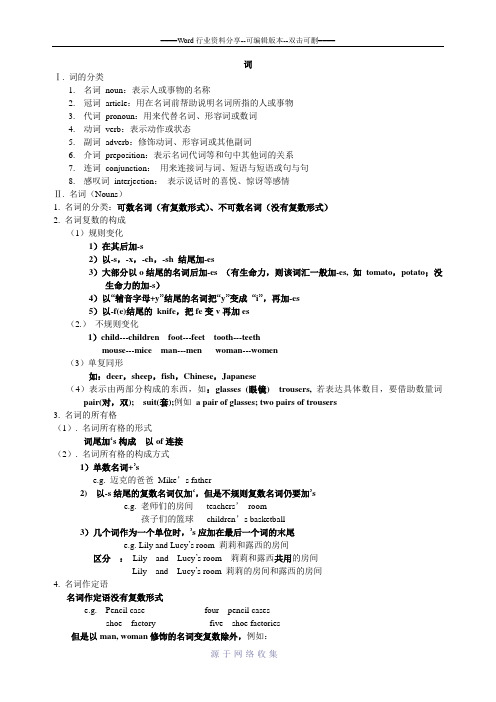
词Ⅰ. 词的分类1.名词noun:表示人或事物的名称2.冠词article:用在名词前帮助说明名词所指的人或事物3.代词pronoun:用来代替名词、形容词或数词4.动词verb:表示动作或状态5.副词adverb:修饰动词、形容词或其他副词6.介词preposition:表示名词代词等和句中其他词的关系7.连词conjunction:用来连接词与词、短语与短语或句与句8.感叹词interjection:表示说话时的喜悦、惊讶等感情Ⅱ. 名词(Nouns)1. 名词的分类:可数名词(有复数形式)、不可数名词(没有复数形式)2. 名词复数的构成(1)规则变化1)在其后加-s2)以-s,-x,-ch,-sh 结尾加-es3)大部分以o结尾的名词后加-es (有生命力,则该词汇一般加-es, 如tomato,potato;没生命力的加-s)4)以“辅音字母+y”结尾的名词把“y”变成“i”,再加-es5)以-f(e)结尾的knife,把fe变v再加es(2.)不规则变化1)child---children foot---feet tooth---teethmouse---mice man---men woman---women(3)单复同形如:deer,sheep,fish,Chinese,Japanese(4)表示由两部分构成的东西,如:glasses (眼镜)trousers,若表达具体数目,要借助数量词pair(对,双);suit(套);例如a pair of glasses; two pairs of trousers3. 名词的所有格(1). 名词所有格的形式词尾加‘s构成以of连接(2). 名词所有格的构成方式1)单数名词+’se.g. 迈克的爸爸Mike’s father2) 以-s结尾的复数名词仅加‘,但是不规则复数名词仍要加’se.g. 老师们的房间teachers’room孩子们的篮球children’s basketball3)几个词作为一个单位时,’s应加在最后一个词的末尾e.g. Lily and Lucy’s room 莉莉和露西的房间区分:Lily and Lucy’s room 莉莉和露西共用的房间Lily and Lucy’s room 莉莉的房间和露西的房间4. 名词作定语名词作定语没有复数形式e.g. Pencil case ------------- four pencil casesshoe factory ----------- five shoe factories但是以man, woman修饰的名词变复数除外,例如:a man doctor ---------------- three men doctorsa woman teacher -------------- ten women teachersⅢ. 代词(Pronouns)1. 代词的分类人称代词(Personal Pronouns)物主代词(Possessive Pronouns)形容词性物主代词名词性物主代词指示代词(Demonstrative Pronouns)2. 人称代词1)2)人称代词有主格和宾格之分。
人教版英语七年级上册单词短语及句型总复习

人教版英语七年级上册单词、短语及句型总复习Unit One单词my [mai] 我的name ['neim] 名字,名称is[iz] 是(be的现在式第三人称clock [klk] 时钟I[ai] 我am [m] 是nice [nais] 美好的;令人愉快的to [tu:] 用于与动词原形一起构成动词不定式prep.meet [mi:t] 遇见,相逢you [ju:] 你(们)what [wt] 什么your [j:] 你(们)的hello [he'lu] 喂,哈罗hi[hai] 嗨!(表示问候或用以his [hiz] pron. 他的and [nd] conj. 和,与her [h:] pron. 她的question ['kwestn] n. 问题,疑问answer ['ɑ:ns] v. 回答look [luk] v. 看first [f:st ] a. 第一的firstname [f:st neim] 名字last [lɑ:st ] a. 最后的;最近的lastname [lɑ:st neim] 姓氏boy [bi ] n. 男孩girl [g:l] n. 女孩zero ['ziru] num. 零one [wn] num. 一two [tu:] num. 二three [θri:]num. 三four [f:] num. 四;five [faiv] num. 五;six [siks] num. 六seven['sevn] num. 七eight [eit] num. 八;nine [nain] num. 九;telephone['telifun] n. 电话number ['nmb] n. 号码;数字telephonenumber [telifun nmb] 电话号码phone [fun] n. 电话phonenumber [fun nmb] 电话号码it [it] pron. 它card [kɑ:d] n. 卡片IDcard (ID=identification) [ai'di: kɑ:d] n. 身份证family ['fmili] n. 家庭familyname ['fmili neim] 姓氏句型1.---What’s your name你的名字是什么?2.—My name is Gina.我的名字是吉娜。
人教版(2024)七年级英语上册期中综合复习专题01 重点词汇,短语,句子归纳(默写版)

专题01 重点词汇,短语,句子归纳Starter Unit1背诵单一.词型转换1.greet- (名词)——2.spell- (名词) ——3.goodbye- (同义词) ——二.必会短语1.过渡单元2.与人打招呼3.向某人问好4.互相;彼此5.你的名字6.开始对话7.我的名字8.拼写你的名字9.叫我. .......10.让我们做.11.去上课三.必会句子1.早上好。
2.见到你很高兴。
3.“你叫什么名字?4.你怎样与人打招呼?5.“A在哪儿? -Where is A? “A在这儿。
-A is here6.“你好吗? “7.能告诉我你的名字吗? 8.你怎样拼写你的名字?9.你可以叫我爱玛。
10.我很好。
11.铃响了。
12.咱们去上课吧。
13.到上课的时间了。
14.你怎样开始对话?Starter Unit2一.词型转换1.bottle- (复数形式)——2.eraser- (复数形式)——3.key- (复数形式) ——4.thing- (复数形式) ——二.必会短语1.什么颜色2.滕飞的书包Teng Fei's s3.亚明的自行车Yaming's4.彼得的裤子Peter's5.在书桌上the desk6.在盒子里the box7.在床下the bed8.在你的书桌下面your desk9.保持……整洁keep 10.找到我的新帽子my new cap11.需要做某事to do sth.12.一副,一双a of13.新眼镜new14.在你的头上on your三.必会句子1.你的书包里有什么? ?2.它是什么颜色的? ?3.不要起得太晚! !4.哦,它在这儿。
Oh5.你需要保持你的房间整洁。
6.我找不到我的新眼镜了。
7.不用谢。
8.爱玛的爸爸有一副新眼镜。
9.你把你的东西放在哪里了?10.等一下。
Starter Unit3一.词型转换1.carrot- (复数形式) ——2.goose- (复数形式) ——3.this- (对应词) ——4.those- (对应词) ——5.tomato- (复数形式) ——6.potato- (复数形式) ——二.必会短语1.番茄秧plants2.苹果树apple3.在院子里in the4.在阳光下in the5.讲笑话tell6.在农场7.许多种类的many of8.看;瞧at9.黑白相间的and white三.必会句子1.这些/那些是什么?2.海伦在院子里看到了什么动物?3.你可以看到很多种动物。
初一英语上册复习资料
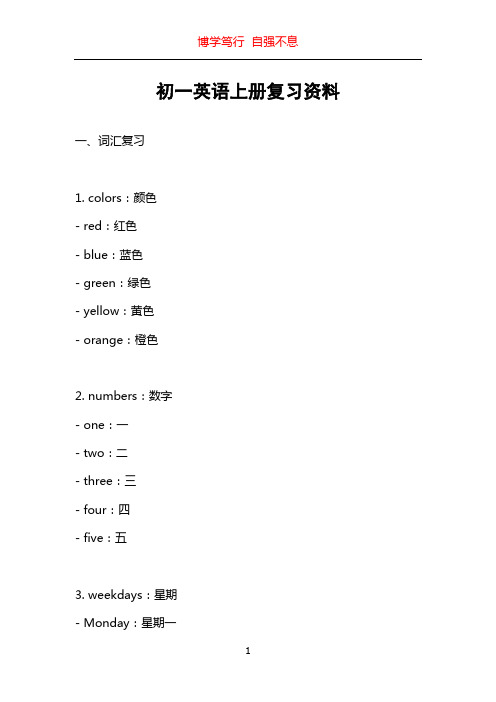
初一英语上册复习资料一、词汇复习1. colors:颜色- red:红色- blue:蓝色- green:绿色- yellow:黄色- orange:橙色2. numbers:数字- one:一- two:二- three:三- four:四- five:五3. weekdays:星期- Monday:星期一- Tuesday:星期二- Wednesday:星期三- Thursday:星期四- Friday:星期五4. family members:家庭成员- father:父亲- mother:母亲- sister:姐妹- brother:兄弟5. school subjects:学科- English:英语- Math:数学- Science:科学- History:历史- Geography:地理二、语法复习1. 人称代词人称代词用来代替特定的人或物。
常见的有:I、you、he、she、it、we、they。
例如:- My name is Tom. I am a student.- She is my sister. She is ten years old.2. 形容词形容词用来描述事物的特征或性质。
通常放在名词之前。
例如:- This is a big dog.- The red car is mine.3. 一般现在时一般现在时用来表达经常发生的动作、习惯、真理或客观存在的事实。
例如:- We have English class on Monday.- Birds can fly in the sky.4. There is/areThere is用来描述某地或某事物存在一个人或物,而there are则表示存在多个人或物。
例如:- There is a cat in the room.- There are some books on the table.三、阅读理解My FamilyHello, my name is Jack. I have a small family. There are four people in my family. My father is a teacher. He teaches English at a school. My mother is a doctor. She works at a hospital. I have a younger brother. His name is Tom. He is in the same school as me. We all love each other very much.根据短文内容,回答以下问题:1. How many people are there in Jack's family?2. What does Jack's father do?3. Where does Jack's mother work?4. Is Tom older or younger than Jack?5. Do they love each other?答案:1. There are four people in Jack's family.2. Jack's father is a teacher.3. Jack's mother works at a hospital.4. Tom is younger than Jack.5. Yes, they love each other.四、书面表达请根据以下要点写一篇介绍自己的短文。
期末复习重点语法 人教版英语七年级上册+
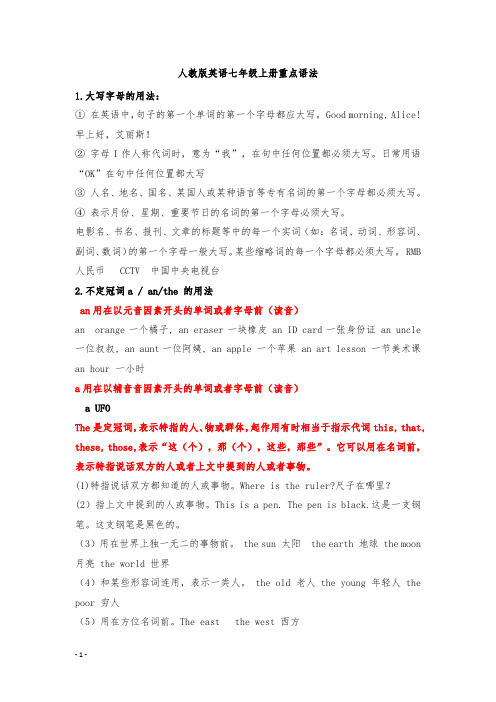
人教版英语七年级上册重点语法1.大写字母的用法:①在英语中,句子的第一个单词的第一个字母都应大写。
Good morning, Alice! 早上好,艾丽斯!②字母I作人称代词时,意为“我”,在句中任何位置都必须大写。
日常用语“OK”在句中任何位置都大写③人名、地名、国名、某国人或某种语言等专有名词的第一个字母都必须大写。
④表示月份、星期、重要节日的名词的第一个字母必须大写。
电影名、书名、报刊、文章的标题等中的每一个实词(如:名词、动词、形容词、副词、数词)的第一个字母一般大写。
某些缩略词的每一个字母都必须大写。
RMB 人民币 CCTV 中国中央电视台2.不定冠词a / an/the 的用法an用在以元音因素开头的单词或者字母前(读音)an orange一个橘子, an eraser一块橡皮 an ID card一张身份证 an uncle 一位叔叔, an aunt一位阿姨, an apple 一个苹果 an art lesson 一节美术课an hour 一小时a用在以辅音音因素开头的单词或者字母前(读音)a UFOThe是定冠词,表示特指的人、物或群体,起作用有时相当于指示代词this, that, these, those,表示“这(个),那(个),这些,那些”。
它可以用在名词前,表示特指说话双方的人或者上文中提到的人或者事物。
(1)特指说话双方都知道的人或事物。
Where is the ruler?尺子在哪里?(2)指上文中提到的人或事物。
This is a pen. The pen is black.这是一支钢笔。
这支钢笔是黑色的。
(3)用在世界上独一无二的事物前。
the sun 太阳 the earth 地球 the moon 月亮 the world 世界(4)和某些形容词连用,表示一类人。
the old 老人 the young 年轻人 the poor 穷人(5)用在方位名词前。
人教版初一上册英语知识点归纳总结

人教版初一上册英语知识点归纳总结一、48个国际音标及26个英文字母的正确书写要熟练掌握元音和辅音,5个元音字母(a, e, i, o, u),字母的正确占格及单词间距。
二、be动词的用法be动词有三种变形,分别是:am, is, are。
记忆口诀:我用浡?你用are, is用于他、她、它;单数全都用is,复数全部都用are。
三、人称及人称代词的不同形式(主格和宾格)1、三种人称:第一人称(I, we),第二人称(you, you),第三人称(he, she, it,Maria)。
2、人称代词的主格,即人称代词位于句子主语位置时的形态:I, We, You,You, He, She, It, Maria。
3、人称代词的宾格,即人称代词位于句子宾语位置时的形态:me, us, you,you, him, her, it。
4、形容词性物主代词:my, our, your, your, his, her, its, their。
5、名词性物主代词:mine, ours, yours, yours, his, hers, its, theirs。
6、反身代词:myself, ourselves, yourself, yourselves, himself, herself, itself,themselves。
四、基数词(表示数量多少的词,大致相当于代数里的自然数) zero, one, two, three, four, five, six, seven, eight, nine, ten, eleven, twelve,thirteen, fourteen, fifteen, sixteen, seventeen, eighteen, nineteen, twenty,twenty-one, twenty-two, twenty-three,twenty-four, twenty-five, twenty-six,twenty-seven, twenty-eight, twenty-nine, thirty, forty, fifty, sixty,seventy, eighty,ninety, one hundred,one hundred and one。
最新人教版七年级(初一)上册英语总复习资料

最新人教版七年级(初一)上册英语总复习资料单元总复Unit 1:你叫什么名字?- 本单元主要研究问候语、自我介绍及询问对方姓名等。
- 要点总结:掌握问候语、介绍自己及询问对方姓名的表达方式,能够熟练运用所学表达方式进行日常交际。
Unit 2:你喜欢什么颜色?- 本单元主要研究有关颜色、物品、人物等方面的表述方式。
- 要点总结:掌握描述物品、人物、颜色等方面的常用句型,能够正确、流利地表达与描述这些内容。
Unit 3:他穿什么衣服?- 本单元主要研究服装及气候方面的相关表达方式。
- 要点总结:掌握描述穿衣、气候等方面的基础语句,能够灵活运用所学内容进行简单交际。
Unit 4:她喜欢听音乐吗?- 本单元主要研究家庭、音乐及娱乐方面的相关表达方式。
- 要点总结:掌握询问个人爱好及描述家庭成员的表达方式,能够较为流利地表达这些内容。
Unit 5:你们学校的图书馆怎么样?- 本单元主要研究学校设施及活动的相关表达方式。
- 要点总结:掌握询问学校设施和活动的表达方式,能够简单描述所属学校相关环境。
Unit 6:他怎么上学?- 本单元主要研究交通工具及出行方式的相关表达方式。
- 要点总结:掌握询问及描述交通工具和出行方式的基础表达方式,能够应对日常生活相关情境。
语法重点- 现在进行时:表示现在正进行着的动作或状态,形式为“be+现在分词”。
- 物主代词:表示物主关系的代词,包括my、your、his、her、its、our、their。
- 人称代词:表示人称关系的代词,包括I、you、he、she、it、we、they。
词汇总结- 掌握1000左右的常用英语词汇,包括动词、名词、形容词等方面。
- 建议根据自己的研究进度制定相应的词汇研究计划。
阅读材料- 阅读理解:读懂英文短文,抓住文章的主旨和信息细节。
- 书面表达:能够用英语进行简短书面表达。
口语练- 提高口语速度和表达流利度,建议多进行和他人的英语对话练,或参加英语角等相关活动。
新版人教版英语七年级上册复习大纲教案知识点总结
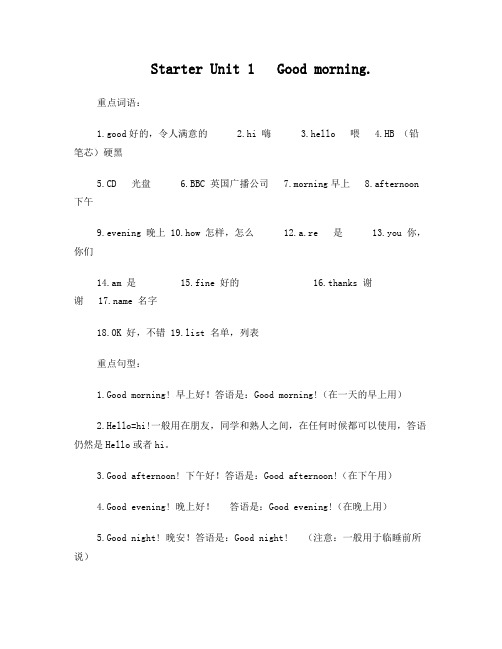
Starter Unit 1 Good morning.重点词语:1.good好的,令人满意的2.hi 嗨3.hello 喂4.HB (铅笔芯)硬黑5.CD 光盘6.BBC 英国广播公司7.morning早上8.afternoon 下午9.evening 晚上 10.how 怎样,怎么 12.a.re 是 13.you 你,你们14.am 是 15.fine 好的 16.thanks 谢谢 名字18.OK 好,不错 19.list 名单,列表重点句型:1.Good morning! 早上好!答语是:Good morning!(在一天的早上用)2.Hello=hi!一般用在朋友,同学和熟人之间,在任何时候都可以使用,答语仍然是Hello或者hi。
3.Good afternoon! 下午好!答语是:Good afternoon!(在下午用)4.Good evening! 晚上好!答语是:Good evening!(在晚上用)5.Good night! 晚安!答语是:Good night! (注意:一般用于临睡前所说)6.Nice to meet you.“很高兴见到你。
”答语是:Nice to meet you.或Nice to meet you,too.(注意这是两个初次见面的人互相打招呼的用语。
)7.How do you do? “你好。
”答语是:How do you do?(注意:用于初次见面,是非正式的打招呼用语。
)8.How are you?你好吗?答语是:I'm fine./Fine./I'm OK.(Thanks.And you?/How about you?)9A:Hello,Frank! B:Hi,Cindy!How are you? A:I'm fine,thanks.10.— Good morning, Dale! — Good morning, Alice!— Good afternoon, Helen! — Good afternoon, Eric!— Good evening, Bob! — Good evening, Cindy!— Good night, Frank! — Good night, Grace!11.— Nice to meet you, Gina! — Nice to meet you, too!—Hello, I’m Alan!— Nice to meet you, Alan!12.— How do you do? — How do you do?13.— How are you, Mary? —( I’m ) Fine, thank you.— How is Jenny? — She is fine, thanks.— How is Jim? — He is OK, thank you very much.— How are Jack and Mike? — (They are) very well, thank you.— Are you fine? — Yes, I am.— Is she(he) fine? — Yes, she (he) is.— Are your parents fine? — No, they are not very well.重点知识点:1.早上(上午)/下午/晚上好。
人教版七年级上册英语复习提纲(背诵版)

人教版七年级上册英语复习提纲(背诵版) Unit 1 My name's Gina.- Review of introducing oneself and others- Vocabulary: name, spell, first, last, letter- Grammar: Using "to be" in present tense- Dialogue practice: Introducing oneself and othersUnit 2 This is my sister.- Review of family members- Vocabulary: sister, brother, mother, father, parent, baby- Grammar: Using possessive adjectives (my, your, his, her, our, their)- Dialogue practice: Talking about family membersUnit 3 Is this your pencil?- Review of school supplies- Vocabulary: pencil, pen, book, ruler, eraser, pencil case, dictionary- Grammar: Asking and answering questions with "Is this/that your...?"- Dialogue practice: Asking and answering questions about school suppliesUnit 4 Where's my backpack?- Review of prepositions of place- Vocabulary: backpack, desk, chair, floor, wall, door, window- Grammar: Asking and answering questions with "Where's...?" and using prepositions of place (on, in, under, behind, in front of, next to) - Dialogue practice: Asking and answering questions about the location of objectsUnit 5 Do you have a soccer ball?- Review of sports and leisure activities- Vocabulary: soccer ball, basketball, baseball, ping-pong ball, tennis racket, swim, bike- Grammar: Asking and answering questions with "Do you have a...?" and using "Yes, I do"/"No, I don't"- Dialogue practice: Asking and answering questions about sports and leisure activitiesUnit 6 What time is it?- Review of telling time- Vocabulary: hour, minute, o'clock, half past, quarter past/to- Grammar: Asking and answering questions with "What time is it?"- Dialogue practice: Asking and answering questions about timeUnit 7 I go to school by bus.- Review of transportation and places in town- Vocabulary: bus, subway, bike, school, library, park, store, post office- Grammar: Using prepositions of transportation (by, on, in) and asking and answering questions with "How do you go to...?"- Dialogue practice: Asking and answering questions about transportation and places in townUnit 8 My birthday is in December.- Review of months and dates- Vocabulary: January, February, March, April, May, June, July, August, September, October, November, December- Grammar: Using "in" for months and asking and answering questions with "When is your birthday?"- Dialogue practice: Talking about birthdays and datesUnit 9 What does he look like?- Review of physical descriptions- Vocabulary: tall, short, thin, heavy, young, old, hair, eyes- Grammar: Asking and answering questions with "What doeshe/she look like?" and using adjectives to describe physical appearance- Dialogue practice: Asking and answering questions about physical appearanceUnit 10 I'd like some noodles.- Review of food and drink vocabulary- Vocabulary: noodles, rice, dumplings, chicken, beef, fish, vegetable, fruit, water, juice- Grammar: Ordering food and drink with "I'd like..." and using "please" and "thank you"- Dialogue practice: Ordering food and drink in a restaurant or caféConclusion。
人教版七年级英语上册知识点归纳总复习

人教版七年级英语上册知识点总复习Unit 1 My name’s Gina.一、短语归纳:1.your name你的名字2.first name 名字st name 姓氏4.her name 她的名字5.in China 在中国二、必背典句:1.―Nice to meet you! 见到你很高兴!―Nice to meet you,too. 见到你我也很高兴。
2.―What’s your name? 你的名字是什么?―Alan. 艾伦3.I’m Jenny 我是珍妮。
4. What’s his / her name? 他的/她的名字是什么?5. Her name’s Mary. 她的名字是玛丽。
6. What’s your first/last name? 你的名字/姓氏是什么?三、形容词性物主代词物主代词是表示所有关系的代词,是人称代词的属格形式。
它分第一人称、第二人称和第三人称,每个人称又分单数和复数。
物主代词分形容词性物主代词和名词性物主代词。
形容词性物主代词的用法和形容词的用法相似,具有形容词的性质。
在句中作定语,修饰名词,一般放在被修饰的名词前,不能单独使用。
如果名词前还有其他的定语,物主代词要放在其他定语的前面。
四、be动词用法1.be动词(am, is, are)这三个动词常用做连系动词,在句子中起连接主语和表语的作用。
This is my mother. 这是我的妈妈。
I am nine. 我九岁了。
You are my good friend. 你是我的好朋友。
2.be动词三种形式的使用主要取决于主语。
主语是第一人称I(我)时,用am,主语是第二人称you(你,你们)或名词及代词的复数时,用are,主语是第三人称单数it / he / she (它/他/她)或名词及代词单数时,用is.3.am , is, are的意思是“是”,但不能处处翻译成“是”。
例,How are you? 你好吗?五、What引导的特殊疑问句英语中用于提出疑问的句子叫疑问句,以what等特殊疑问词开头的句子叫特殊疑问句,用法如下:1.询问姓名,―What’s your name? 你的名字是什么?―Alan. 艾伦。
人教版七年级英语上册期末总复习(详细)

them
their
theirs
形容性物主代词+名词=名词性物主代词; 形容性物主代词后面必须加名词,名词性物主代词后面
一定不能加名词。
含有实义动词的句子结构: 肯定句:主语 + 动词原形 / 单三 + 其他. 否定句:主语 + don’t / doesn’t + 动词原形 + 其他. 一般疑问句:Do / Does + 主语 + 动词原形 + 其他?
strawberry – strawberries 4.以“元音字母+y”结尾的名词,直接在词尾加-s . key –keys ; 6.以o结尾的名词,表示无生命事物的名词加-s,表示有生 命事物的名词加-es. photo – photos ; radio – radios ;tomato – tomatoes
Those two girls are my sister Cindy and my cousin Helen. 那两个女孩是我的妹妹Cindy和我的表妹Helen。
Have a good day! 玩得开心。
who’s=who is ; who’re=who are ; they’re=they are
My brother and I are in the same school.
=My brother and I go to the same school. 我的哥哥和我在同一所学校。(are in the same class )
I don’t think..... 我不认为…… I don't know....我不知道......
The white model plane is hers. 这个白色的飞机模型是她的。
人教版初一上册英语知识点归纳总结
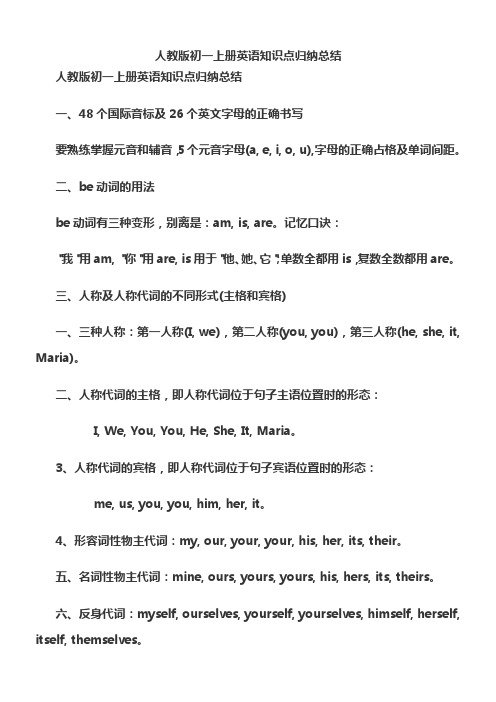
人教版初一上册英语知识点归纳总结人教版初一上册英语知识点归纳总结一、48个国际音标及26个英文字母的正确书写要熟练掌握元音和辅音,5个元音字母(a, e, i, o, u),字母的正确占格及单词间距。
二、be动词的用法be动词有三种变形,别离是:am, is, are。
记忆口诀:"我"用am, "你"用are, is用于"他、她、它";单数全都用is,复数全数都用are。
三、人称及人称代词的不同形式(主格和宾格)一、三种人称:第一人称(I, we),第二人称(you, you),第三人称(he, she, it, Maria)。
二、人称代词的主格,即人称代词位于句子主语位置时的形态:I, We, You, You, He, She, It, Maria。
3、人称代词的宾格,即人称代词位于句子宾语位置时的形态:me, us, you, you, him, her, it。
4、形容词性物主代词:my, our, your, your, his, her, its, their。
五、名词性物主代词:mine, ours, yours, yours, his, hers, its, theirs。
六、反身代词:myself, ourselves, yourself, yourselves, himself, herself, itself, themselves。
四、基数词(表示数量多少的词,大致相当于代数里的自然数)zero, one, two, three, four, five, six, seven, eight, nine, ten, eleven, twelve, thirteen, fourteen, fifteen, sixteen, seventeen, eighteen, nineteen, twenty, twenty-one, twenty-two, twenty-three,twenty-four, twenty-five, twenty-six, twenty-seven, twenty-eight, twenty-nine, thirty, forty, fifty, sixty,seventy, eighty, ninety, one hundred,one hundred and one。
人教版七年级上册英语 单元知识整理

人教版七年级上册英语一、Unit 1 Where's your pen pal from?1.词汇1) pen pal2) from3) Canada4) England5) Australia2.句型1) Where's your pen pal from?2) He's from Canada.3.语法1) be动词( am, is, are) 的用法2) 询问交际对象的国籍二、Unit 2 My day1.词汇1) get up2) have3) breakfast4) go to school5) have lessons6) have lunch7) go home8) do homework9) go to bed2.句型1) What time do you get up?2) I get up at six thirty.3) What do you do at school?4) I have lessons.3.语法1) 一般现在时的用法2) 表达日常活动的动词短语三、Unit 3 Is this your skirt?1.词汇1) skirt2) dress3) sweater4) T-shirt5) hat7) shorts8) coat9) shoes10) socks11) bag12) colours (colors)2.句型1) Is this your shirt?2) Yes, it is. / No, it isn't.3) What colour is it?4) It's white.3.语法1) 物主代词(形容词性物主代词和名词性物主代词)的用法2) 询问物品的颜色四、Unit 4 What's this in English?1.词汇1) map2) book3) desk5) ruler6) pen7) teacher8) student9) blackboard10) door11) window2.句型1) What's this in English?2) It's a map.3.语法1) 物品名称的表达方式2) 询问物品在英语中的名称五、Unit 5 Do you like pears?1.词汇1) like2) pear3) banana4) orange5) mango6) pineapple7) watermelon8) apple9) grape10) strawberry11) lemon12) peach2.句型1) Do you like pears?2) Yes, I do. / No, I don't.3) What fruit do you like?4) I like apples.3.语法1) 表达食物喜好的动词( like, love, hate) 的用法2) 询问食物喜好六、Unit 6 I'm watching TV.1.词汇1) watch TV2) read3) newspaper4) ic book5) listen to music6) clean7) room8) do9) homework2.句型1) What are you doing?2) I'm watching TV.3.语法1) 现在进行时的用法2) 表示正在进行的动作。
- 1、下载文档前请自行甄别文档内容的完整性,平台不提供额外的编辑、内容补充、找答案等附加服务。
- 2、"仅部分预览"的文档,不可在线预览部分如存在完整性等问题,可反馈申请退款(可完整预览的文档不适用该条件!)。
- 3、如文档侵犯您的权益,请联系客服反馈,我们会尽快为您处理(人工客服工作时间:9:00-18:30)。
词汇
一、单词
1. 介词:in, on, under, behind, near, at, of
1). in表示"在……中","在……内"。
例如:in our class 在我们班上
in my bag 在我的书包里in the desk 在桌子里in the classroom 在教室里2). on 表示"在……上"。
例如:
on the wall 在墙上on the desk 在桌子上on the blackboard 在黑板上3). under表示"在……下"。
例如:
under the tree 在树下under the chair 在椅子下under the bed 在床下4). behind表示"在……后面"。
例如:
behind the door 在门后behind the tree 在树后
5). near表示"在……附近"。
例如:
near the teacher's desk 在讲桌附近near the bed 在床附近
6). at表示"在……处"。
例如:
at school 在学校at home 在家at the door 在门口
7). of 表示"……的"。
例如:
a picture of our classroom 我们教室的一幅画 a map of China 一张中国地图
2. 冠词a / an / the:
冠词一般位于所限定的名词前,用来署名名词所指的人或事物。
冠词有不定冠词和定冠词两种。
不定冠词有两个形式,即a和an。
a用在以辅音音素开头的词前,如a book; an用在以元音音素开头的字母前,如an apple.
a或an与可数名词单数连用,泛指某类人或某物中的一个。
This is a cat. 这是一只猫。
It's an English book. 这是一本英语书。
His father is a worker. 他的爸爸是个工人。
the既可以用在可数名词前,也可以用在不可数名词前,表示某个或某些特定的人或事物,也可以指上文提到过的人或事物。
Who's the boy in the hat? 戴帽子的男孩是谁呀?
------ What can you see in the classroom? 你能在教室里看到什么呀?
------ I can see a bag. 我能看见一个书包。
------ Where's the bag? 书包在哪呀?
------ It's on the desk. 在桌子上。
3.some和any
①在肯定句中用some.例如:
There are some books on the desk.桌子上有一些书。
Lucy has some good books露西有一些好书。
②在疑问句和否定句中用any。
例如:
Is there any ink in your pen?你的钢笔里有墨水吗?
Do you have any brothers and sisters?你有兄弟姐妹吗?
There isn't any water in the glass.杯子里没有水。
记住它们的特殊用法。
①some亦可用于表示盼望得到对方肯定的答复或表示建议、委婉请求的疑问句中,这一点我们不久就会学到。
例如:
Would you like to have some apples?你想吃苹果吗?
②any也可用于肯定句中,表示"任何的"。
例如:
Any one of us can do this.我们当中任何一个都能做这个。
some 和any的用法是经常出现的考点,希望大家能准确地掌握它们的用法。
4.family
family看作为一个整体时,意思是"家庭",后面的谓语动词be用单数形式is ;如把family看作为家庭成员时,应理解为复数,后面的谓语动词be应用are。
My family is a big family. 我的家庭是个大家庭。
My family are all at home now. 我的家人现在都在家。
Family强调由家人组成的一个集体或强调这个集体中的成员。
home指个人出生、被抚养长大的环境和居住地点。
house指"家"、"房屋",侧重居住的建筑本身。
His family are all workers. 他的家人都是工人。
My home is in Beijing. 我的家在北京。
He isn't at home now. 他现在不在家。
It's a picture of my family. 这是一张我全家的照片。
5. little的用法。
